In early ’06 I retired from the Maryland Army National Guard. One of the negotiations in coming to that decision was, in return for eliminating the absences brought on by that commitment, I was given the authorization by my wife Katie, to be absent one week (stretched at times) a year for a hunting holiday. I was focused on making this count, with a goal of travel and exploration as a big part of that plan. My first choice was to find the wildest place I thought I could get into within the lower 48. After a bit of browsing of national forests I came upon the Gila National Forest. Located in southwest New Mexico–not too far removed from the border territories–it is a huge expanse of wild lands covering a big piece of the Rocky Mountains along the continental divide. It varies from what looks like straight desert with small cactus brush and prickly pear, to high mountains with scrub juniper and pine covered mountainsides. My weapon of choice through these journeys has been a Great Plains “Long Curve” recurve bow. It is a light weapon and a joy to carry, has a long bow grip and recurve form. Being one piece, it is always an airline challenge, but I have devised a system with a padded fishing rod carrier that provides excellent protection.
For this first trip I ensnared a close friend who was willing to risk the unknown with bow in hand. Dave is just about the perfect victim, always willing to take a risk, with a great attitude through the worst conditions. His only fault is his servitude to speed and the wheelie bow, but we have hope for his future, especially since I have proven that our success ratios are equal, but I don’t have a heavy mechanical bow to tote everywhere. His participation in this event was almost ended by an ankle twisting injury about a week before we left, so he went into this one with a rough limp but a good attitude, and he persevered.
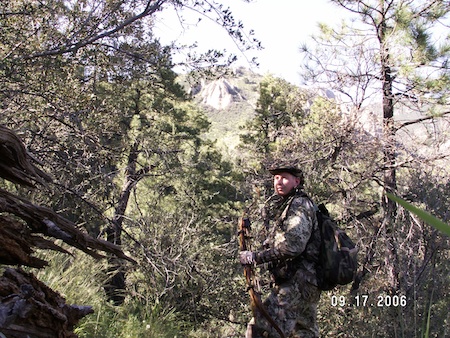
After some internet and phone research with the local Forest Service rangers and biologists, we chose a starting point in a deep valley that had no access points other than up a boulder choked streambed for about five or six miles, or over some very nasty heights. This was within our designated zone, and these western hunting zones were as large as some of our states back east. Our quarry was mule deer, and looking for a velvet-antlered buck was the dream guiding our hunt. Being flatlanders from Maryland, we spent the first two or three days with varying degrees of headaches and muscle aches from the combination of dehydration, altitude, and tough terrain. Most of this area ranged 7-10,000 feet. Rather than pack water we carried filter bottles, which worked out fine. Our packs weighed about 70-80 lbs. each, (something we learned not to repeat) and we worked very hard on the trip in, sweating profusely for a day of hard work.
The terrain was absolutely beautiful with high boulder strewn ridgelines and patches of large pines along the lower hillsides and bottoms. Recent heavy rains had also added to the scenery with bright flowers and green grasses throughout. Our hike in required a straight frontal attack up the stream, with lots of difficult ankle-twisting rocks. I don’t know how Dave managed that with his sore ankle, but he made it with a smile! I think it was pure adrenaline from being on this great adventure, on our own, into the Western wilderness.
We saw some deserted silver mines along the way and even stopped to explore a short distance into one mine. Dave, being a fully engaged rock nerd–as the mineral collectors like to call themselves–had to have a look. Dripping water and rotted timbers kept me from venturing past the point where I could see bright sunny skies at the entrance to the mine. These abandoned mines, and the stories they represented, gave me a feel for the gold and silver rush days of the old West.
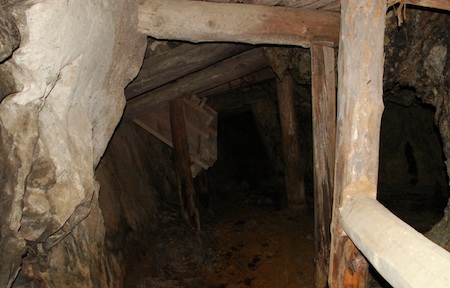
We camped alongside the stream near some tall pines, where we hung our food supplies. Another learning point; MRE’s (Meal Ready to Eat) are not the best option for taste and enjoyment! Dave had a great laugh when I caught my canteen on a high branch while hanging the food, and the branch it was hung on broke. The canteen came back at high speed and ricocheted off my forehead to knock me flat. His laughing felt a little beyond what it should have been. Later in the trip he returned the favor fully as he attempted to cross a high barbed wire fence. Not being an experienced farm boy, he landed straddling the wire when the tilted rock he was perched on rolled! I laughed until the tears rolled.
We hunted that valley hard for three days and only saw one bedded doe at a high elevation. The local deer seemed very much wired and were picking us up so that all we saw were tracks. We were to learn why the following day. We were up and out before dawn, working the hillsides and valley offshoots between the cliffs and the forest interchange. Nothing was seen, as usual. Late that morning, as I strolled leisurely down the trail to the tent, I stumbled onto a sight that had me frozen in my tracks. About 70 yards short of the tent, lying on the side of the trail at my feet, was a fawn mulie with its neck broken and a claw mark clearly visible. It was missing its liver and lungs–killed sometime early that morning! At first I was really tense as I scanned the surrounding brush worried that I had disturbed the owner of that feast. Then, as I looked a little, I calmed down when I noticed the gathering yellow jackets and flies. I figured maybe it had been deserted for a little while. It brought back to mind what had happened during the night…
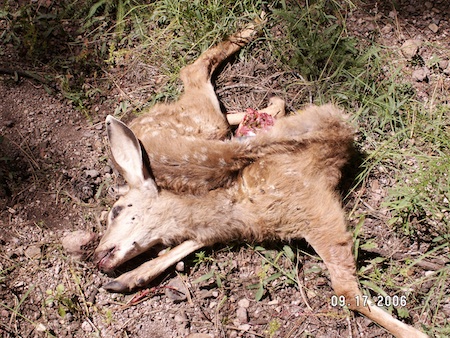
Being rather tall, Dave was about an inch too long for our tent, therefore his head was in constant contact with the back wall. At some point late into the night Dave woke me with a quick worried comment. “Hey, something’s pushing on my head!” We listened to “something” scamper away into the dark, and then we went back to sleep. It is my firm belief that Dave had been nuzzled by that something, trying to determine if he was as dead as he smelled after three days and nights in the woods! This kill brought back the events, and I believe the owner of the kill was responsible for our midnight awakening. I think Dave had actually been nuzzled by a cougar! And not the variety known to haunt the bars!
We left the valley that afternoon by mutual decision, due to the lack of deer seen in the area. Dave had seen a pair of unusual animals across a draw (later we determined they were badgers) with black and white coloring, but neither of us had yet spotted any desirable game. We pulled out our maps and made a plan for the next stop, moving about 20-30 miles north of our current location. Along the way we treated ourselves to a Pizza Hut stop in town and a visit to the local Forest Ranger HQ. To our surprise the Rangers quickly confirmed that the valley we had been hunting is a favored haunt of a female cougar who liked to raise her young there each year. They said the missing liver and lungs is a common sign that the predator was a cougar. No wonder the deer were so skittish in that valley.
By the way, we dutifully reported our expected hunting grounds and how long we expected to be there, as is always recommended by the safety experts. The information was received with a shrug and a “Good luck fellas,” that had us laughing down the road about the fact that we were truly on our own. No one even cared to write down a note or mark a map. We left feeling like tenderfoots through and through–so much for keeping people informed in case of an emergency.
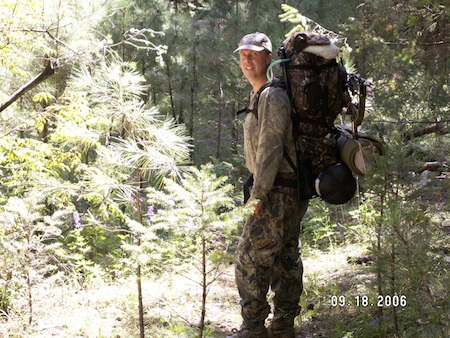
On we went to our next destination, but not without more excitement along the way. As we rolled out of town our minds were focused on the map, but our recent gastric changeover from MRE’s to greasy sausage pizza came back to haunt me all at once with frightening urgency. An immediate sweat broke out on my forehead, and I pounded the dashboard and yelled, “PULL OVER–NOW!” Dave, having no hint as to why, quickly complied, coming to a sliding dust-cloud stop on the shoulder with a look of shock and fear on his face. I hurtled out the door while the vehicle was still in motion and covered about 10 yards of not-nearly-tall-enough sagebrush before dropping behind the one sagebrush that reached knee high. Of course the deserted roadway immediately came to life with locals, no doubt rushing to the Pizza Hut lunch special down the road. It’s amazing how little terrain and vegetation some parts of New Mexico have — visibility for miles. I have to think I ruined a few appetites that day, and one patch of desert will never be the same again! Beware the changeover!
We next moved into an area near the town of Hermosa, down a rough trail that hilariously was called a county road. Hermosa had, in its day, been an important stage coach stop on the trail over the continental divide. Late sunset found us in an undesirable kind of terrain that felt more like the back 40 cow pasture than a prime national forest. There was evidence of heavy cattle use and wired fences, but according to our maps we were clearly into the forest once again. Being too late for a big change of location, and not wanting to travel the rough trail in the dark, we shook out the bags and camped by the car for the night. Despite being in what we thought to be unproductive-looking territory, we woke the next morning and decide to hike back a little ways and check out the area for some good exercise. As we crested the first small ridgeline, and I stopped to lift my binos to scan a hillside, Dave grabbed my arm and said, “Look!” pointing at a spot about 400 yards out on the low end of a hill. We both dropped down instantly as we saw what looked like a huge mule deer buck standing in clear contrast to the surrounding hillside vegetation. The dream was becoming a reality; this was why we had come! We were astounded to actually see such a thing after four days of hard hunting with no sightings. It was unaware of us, so we quickly huddled to make a plan, while watching the buck. I also stopped and snapped a quick, long distance photo. We flipped a coin to see who would go for it, and I won. I planned to circle the large hill by using the bisected terrain, follow a small cut up out of the deer’s possible vision, and then come down from above and behind it. Here is where we made our first tactical error — greed. As we watched the deer, we decided to do a quick scan of the surrounding hills before separating. Bingo! To our east, about 800 yards out, we spotted a group of three or four fine-antlered mulies feeding along a ridgeline. A quick decision had Dave headed that way with his own target, and me on to mine. Looking back we should have worked one at a time, together.
I moved hard and fast up the backside and around the hill, stopped to strip the heavier clothing as I began heating up, then started a slow and careful descent into the area where I had been watching this deer feed. I heard a crunch down the hill in the thicker scrub, and got tense. Next came a “moo” and I could see a couple of cows moving through the dry stream bed. My deer was nowhere in site, but I didn’t see or hear anything to indicate it had spooked. Did the cattle shake it out before I got there? Did it spot me as I crested the hill? Did I stalk past it somewhere on the hill? The wind was good, in my face, so I don’t think I was winded. I’ll never know. I did capture that long distance photo before beginning the stalk, so at least I have that “one that got away” photo.
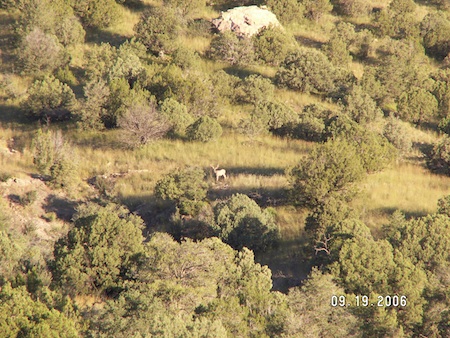
Meanwhile, Dave was involved in his own pursuit. We met up after about three hours and his hunt was fruitless as well. The rough terrain, ascending winds, and multiple sets of eyes appear to have been his downfall on that attempt. We were both tired, but keyed up. We were into mule deer!
The following day turned into our big opportunity. The previous afternoon we had scouted the south end of this new valley, away from where we had missed our opportunities, and we found a decent location to start from at first light. We had chosen a small knoll, central to some severely bisected terrain, with a flat spot about 200 meters square. It provided a way to move from side to side without being seen, but we would be able to cover a large part of the surrounding terrain.
In the early morning light we hiked to this knoll and split up, Dave going south and east and me going to the north and west. As the light began creeping in, I started scanning the distant terrain looking for something to catch my eye as that first deer had done the day before. I wasn’t seeing anything. I lowered my binos to readjust to the general terrain, and as I did I caught a movement just about 100 yards away directly downhill at the base of my knoll — not in the distance as I had anticipated. I was in shock as I watched four mulie bucks move slowly up a draw and disappear into the bush just below me. Their direction of travel would bring them out onto a little trail that ran straight downhill from where I stood.
I had no time to call Dave so, after a quick look over my shoulder to see if he was in sight, I started down as quietly as I could, hoping to intercept them as they came through the brush. They were too fast for me; the first buck cleared the brush about 40 yards below me and turned to feed directly at me. I was pinned, but hidden slightly by a point of brush between us. Unfortunately, it was the smallest of the pack but I was focused and waiting for an opportunity as the deer worked its way straight toward me. At about 12 yards it looked up after a bite and froze, locked on to my form. My adrenaline was really cranking and I was trying to hold back my breath as it clearly fogged out in front of me on the cold morning air. It may have been a young buck but it certainly wasn’t stupid. Without hesitating it went from facing me to crossing the path without ever touching down — blown!
As it moved out the last two bucks (there turned out to be three total) stepped onto the path at about 40 yards and stared up the trail at the escaping buck. Knowing this was the only opportunity I was going to get on these fellows, and having practiced long shots in preparation for this trip, I decided to go for it. I chose the last deer, a solid representation of a mulie with great looking antlers, and locked on to it. Time stood still as I released and nothing moved but the arrow. It was looking great, dead on-line for the crease behind the shoulder and flying down the hill. Suddenly it just dropped like a rock and exploded on the rocky ground about two feet before the deer, scattering it with pebbles and pieces of broken arrow. That deer blew out of there in one leap and was gone forever, but it was burned into my memory forever as well. I have no recollection of what happened with the other deer. My focus was so intense that I didn’t even see it after picking my intended target. What happened? Why did my arrow drop so quickly? I could not understand until I walked down to check the shot. What had looked like a 40-yard shot at a whitetail was actually a 60-yard shot at a large mulie! I was already at my maximum range at 40 yards, and my recurve is just not meant to send an arrow at anything further. I had grossly underestimated the distance. The size of the animal and the broken terrain both led to faulty judgment on the range. I was thankful that it was a clean miss, and proud that at least it had been a smooth release and a perfectly aligned shot despite the pounding heartbeat. Thus ended the activity for that morning, a great experience, but a failed attempt.
Little did we know about the nature of mulies, they seem to have a very low tolerance for disruptions. What I have learned on that trip, and subsequent attempts, is that your first attempt at a mulie will likely be the last attempt at that particular deer. When they notice intrusion they don’t just clear the hill like a whitetail, they seem to clear the county!
We moved camp one more time but stayed within the same general area, focusing on the territory where we had seen the group of bucks feeding along the ridgeline. I spent a fruitless morning in a good ambush position along a cut over that ridge. We did spot one more buck, but it and a doe spooked out as I tried to move around the hilltop into the drainage where I had seen them go. It was a different deer than the one we had watched the day before, slightly smaller in rack and body, but just as wary. I knew the game was over when I heard the distinct bouncing pogo crunches of a deer in flight on the gravelly soil, and then spotted first the doe and then the buck bursting from the hillside about 50 yards downhill where they had bedded. They quickly moved around the corner of the hill and were gone for good. One clear learning point for us was the need for quiet footwear on that gravelly surface. In subsequent trips I have taken “Bears Feet” covers and had great results keeping down the crunch.
That same morning Dave had his close encounter of the furry kind. During the night I had broken a cardinal rule of camping in bear territory and, due to exhaustion, had decided to eat my dinner inside my tent while lying on my sleeping bag. As I tried to shake a pork patty from the MRE pouch I sloshed the hot juice down my chest and over my bag. I did my best to clean it up, but ended up lying there smelling like a giant pork patty. At some point during the night I woke to the sound of a steady gait of crunching gravel coming across the flat in my direction. When I shifted and quickly found my .45 the animal paused, it was just a few feet back from the tent. I gave Dave a shove and said, “Visitor,” then hit the side of the tent and hissed out a “Haaah,” meant to send the animal scampering as it had done successfully in the past. This time there was nothing but silence. I thought uh-oh as things got very tense, then I heard a quiet movement, and a slow and gradual retreat by the animal, not the usual bursting scamper of a raccoon or smaller varmint. Back to sleep once the adrenaline had worn off and things quieted back down.
The next morning, as I sat in ambush along that ridgeline, Dave had moved up a different ridge to the back of our encampment area. As he crossed a fence he came face to face with a young buck that exploded into the brushy hillside, giving him a quick wake up call. As daylight dawned, he spotted an animal moving up the brushy, dry washout near where he was hiding. It was a very respectable-sized black bear heading up to the rim rock to bed down for the day. It strolled past Dave as he held his breath, and the butt of the KABAR I had loaned him, praying that it would not notice and come for him. It passed him at about 25 yards, and continued up the hillside. We had noticed some bear scat the previous day on the nearby ridges, but we hadn’t really expected any encounters and did not purchase a bear tag, so he could only watch as it passed and hoped it would not notice him. Much to his relief, it moved on and out of sight without catching on to his presence.
Dave also had a close encounter with a doe later that last morning. It passed within easy range as he overlooked a trail along the side of a small canyon in the higher reaches, however, the desired buck was not on her trail that day.
We beat the altitude and aching muscles, and the first few days of misery passed quickly with the excitement of the new terrain. By the end of the hunt we were busting over ridgelines a thousand feet up without a thought. We had wild terrain, new experiences, beautiful scenery, different creatures and the adventure fully lived up to our expectations. During this trip we encountered many of the native animals; badgers, coyotes, bear, rabbits and ground squirrels, horny toads and other lizards, hummingbirds, and on subsequent trips we have added to that list with elk, javelina, and Coues deer. On this particular trip we encountered wet conditions beyond the norm for this area. It had rained off and on during the early weeks of September, and the landscape was an explosion of flowers and green vegetation. It is also worth noting that these roads can become impassable during heavy rains so some flexibility in schedule must be understood when venturing back into these off-road destinations. We went home without a kill, but with a full load of memories of the different creatures and experiences of the Gila. I have since been drawn back for a follow up hunt, but that’s another story for another day. I still have a strong desire to return again and explore deeper into those hills. The Gila offers so much area to explore it seems like limitless opportunities. While I did cross a few other hunters on the roads, and passed a few camps, the pressure was not over done and I never crossed another hunter while in the field.
Cost of the trip? Really, it depends on your ability to handle the camping aspects. Once we got there our costs were low. I like to stay out at camp once we get there, and other than a possible resupply or restaurant stop along the way, the greatest cost is in the car rental and airfare. License costs do influence my decisions on where to go, since the travel costs are pretty consistent once you commit to airfare and rental vehicles, and the permit costs do influence my decisions on what to hunt. An elk hunt in the Gila (although we did cross some terrific bulls on a later trip) has a permit that alone is near $900; too rich for me. Here are some rough estimates of our expenditures in 2006:
- Deer License $270
- Airline: $300 Round Trip
- Rental Car: $400
- Fuel: $100
- Hotels (night before flying out)- $100
- Supplies — Wal-Mart visit, water, food, propane etc – $100
- Restaurants: $100
In total we each spent between around $1300. Since for me the adventure is in the planning and seeing new places, great exercise, and camaraderie, I don’t hire guides or book special draw permits, and I accept coming home without meat as more normal than not. The value is in the quest and the events along the way and the places visited. I always want the outcome of a kill, but that is never the primary factor for my hunts, so I accept much fumbling and learning along the way. I am satisfied if the opportunity for a kill is there. Our National Parks offer some great experiences for hunters without special permissions or payments for access, think about them.


Leave A Comment